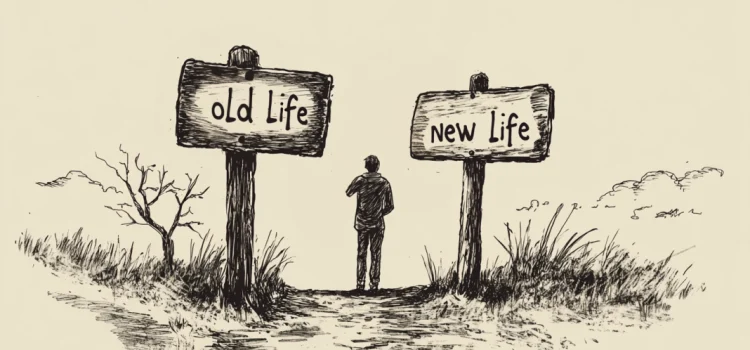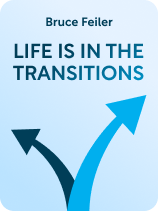

This article is an excerpt from the Shortform book guide to "Life Is in the Transitions" by Bruce Feiler. Shortform has the world's best summaries and analyses of books you should be reading.
Like this article? Sign up for a free trial here.
Want to know how to adapt to changes in your life? How can you embrace a new way of being?
Navigating life changes can be difficult, but Bruce Feiler, the author of Life Is in the Transitions, argues that you can make it easier by approaching it intentionally and proactively. He proposes seven strategies that can help you adapt to life changes.
Keep reading for an in-depth look at each strategy.
Strategy 1: Cope With Your Emotions
Feiler’s first strategy for how to adapt to changes involves understanding and finding ways to cope with the emotions that come up while you’re grieving the end of your old reality—particularly fear, sadness, and shame.
How to Cope With Fear
During his research, Feiler observed that many people had to overcome fear as they transitioned from a major life change. He names a few common strategies that can help with this. The first is to compare the discomfort you feel in your current reality to the fear of making a big life change. Transitions can be scary, but staying stuck in the same old rut forever may be even more terrifying.
Another strategy Feiler recommends is to make a list of your goals, which can motivate you to overcome your fears.
Finally, Feiler says you can choose to face your fears head on—for example, if you’re afraid of going back to school, you might decide to swallow that fear and sign up for classes anyway.
How to Cope With Sadness
Another common emotion people face during life changes is sadness. Feiler notes three strategies people use to cope with sadness. The first is accepting the sadness—allowing it to be part of your story without trying to get rid of it. The second is leaning on loved ones for support while you grieve. The third is facing the source of your sadness by talking about it or deliberately reminding yourself of it, allowing you to fully feel your grief.
How to Cope With Shame
Finally, many people feel shame during transitions as they look back on the perceived failures of their lives. In interviews, Feiler gathered that the best way to combat this shame is to invest time and effort into the aspects of your life that the shame impacts the most. You can do this by taking actions that directly address the areas where you feel you’ve fallen short. For example, if you feel shame about hurting your family and thus feel separated from them, the best way to counteract that shame would be to attend a family event and reconnect with them—to restore your sense of belonging.
Strategy 2: Mourn Deliberately
Feiler’s second strategy for navigating transitions is to mourn deliberately. One way to do this is to create personally significant rituals to mark the ending of one life phase and the beginning of another. These rituals allow you to externalize and honor your grief, whether you’re mourning a literal death or a symbolic one. Processing loss in this way is especially important in the case of traumatic loss—if you don’t process the loss properly, you’re more likely to develop symptoms of trauma later on.
According to Feiler, there are four types of mourning rituals to choose from:
- Individual rituals, where you create or do something personally meaningful to honor what you’ve lost (and what you’ve gained by losing it). For example, one of Feiler’s interviewees ate his first cheeseburger after leaving a religion that forbade it.
- Community rituals, where you process the loss with the help of your community. For example, some people throw divorce parties to celebrate their ending marriages.
- Identity rituals, where you change your name to distance your new and former selves.
- Renewal rituals, where you make changes to your body, habits, or surroundings with the intention of making space for a new chapter of your life to begin. For example, you might overhaul your wardrobe after leaving an industry with a strict dress code.
Another way to mourn deliberately, according to Feiler, is to gather and periodically interact with physical keepsakes that remind you of the thing you’re grieving. Feiler says that such objects encapsulate memories, and interacting with them allows us to revisit those memories whenever we need to. For example, if a friend of yours who was an artist has died, hanging a piece of art on their wall could create opportunities to feel their presence again and remember the moments you shared together.
Strategy 3: Explore New Ways of Being
Feiler explains that one of the most difficult parts of navigating change is deciding your next steps. In the wake of a transformation, your old habits and beliefs no longer fit—so you need to let them die. In some cases, you might welcome this—for example, if you have a health crisis that forces you to stop smoking, you could feel eager to make the change and grateful for the wakeup call. In other cases, letting go of some aspects of your former self can be hard. For example, if you took a pay cut upon accepting a new job, you might struggle to adjust your spending habits. Regardless, Feiler says it’s important to let go of the habits and beliefs that no longer serve you—then, you can replace them with new ones that align with your current reality.
You need to find new ways to fill your days and discover what feels meaningful to you now, but developing new habits and beliefs isn’t always easy. The approach you start with just after a life change may not be the one you stick with, and Feiler says that’s OK. What’s important is that you give yourself opportunities to experiment with potential paths forward.
Feiler explains that you can approach the challenge of figuring out your next steps in one of three ways—by embracing structure, embracing chaos, or seeking wisdom.
Embrace Structure
Feiler says that if you know (or think you know) what you want to do next, you can take steps to pursue it right away. For example, you might enroll in a personal training program to become healthier.
Embrace Chaos
If you’re not sure of your next steps, Feiler says you can explore a variety of potential interests and activities to see what resonates with you. For example, you may dabble in different hobbies, attend various workshops, and volunteer for diverse causes.
Seek Wisdom
If neither of the above options sounds appealing, Feiler suggests that you turn to personal reflection or seek wisdom from others before determining your next steps. For example, you could take up a contemplative practice like tai chi that gives you opportunities to look inward, or you could work with a spiritual advisor or life coach to clarify your values.
Strategy 4: Tap Into Creativity
In Feiler’s research, he found that many people turned to creative outlets during transitional periods of their lives. He explains that creating something can be cathartic, and it’s also a good way to explore the new feelings and ideas that result from transformational experiences.
Here are four ways you can tap into creativity:
Pick up an art or craft you’ve never tried before. Transitions can leave you feeling isolated, bored, or confused. Feiler says these emotions make excellent creative fodder, since they make space for innovative ideas and out-of-character interests to pop up. This makes transitions an excellent opportunity to stretch your creative limits.
Resume an art or craft you forgot you loved. Many people exhibit artistic talents as children or young adults, but they put them aside as life becomes busier and priorities shift. According to Feiler, transitions are a good opportunity to reconnect with the artistic side of yourself.
Find new ways to move your body. Feiler argues that physical movement can unlock ideas and aspects of your personality that have been lying dormant. For example, starting a yoga practice could teach you to connect with your emotions and could promote a sense of inner calm.
Take up writing. Writing helps you organize your thoughts and make sense of your experiences. Feiler says this is especially helpful when you’re experiencing turbulence after a transformative life change.
Strategy 5: Talk About It
Feiler explains that sharing your transformation with others can make enduring the transformation easier. Talking about your experiences cuts through loneliness—which many people experience when their lives are in a state of upheaval—and has even been shown to improve physical health outcomes.
Feiler describes five ways that talking about what you’re going through with others can help you:
You might receive support. Feiler explains that when you share about your life, you give others a chance to understand, comfort, and validate you, which can make the burden you’re carrying feel easier to bear.
You might feel encouraged. According to Feiler, letting others know what you’re dealing with opens the door to advice and points of view that can keep you moving forward. For example, talking with friends about your career options could help you clarify your goals and create an action plan.
You might get a reality check. During a transition, you may be prone to unrealistic or unhelpful thought patterns. Feiler says sharing your thoughts with others allows you to hear outside perspectives that help you see things more clearly.
You might be inspired. If you open up about what you’re going through, you could learn that someone else has been through something similar and emerged stronger. According to Feiler, hearing their stories can offer you hope and can motivate you to persevere.
You might get negative feedback. Feiler acknowledges that not everyone you’re vulnerable with will be sympathetic to your struggles, hopes, and fears. However, if someone reacts poorly to your story, you can still grow from that experience: The desire to prove them wrong or address their criticism can motivate you to work harder, find meaning in your transformation, and create a life worth living.
Strategy 6: Take a Step Into Your New Life
As we’ve discussed, transformations tend to overhaul your entire life, turning you into a different person than you were before. One sign that you’re ready to embrace your new identity is that you start doing mundane tasks that were too difficult to tackle during the most tumultuous parts of your transition. For example, if you broke both your legs, taking a shower standing up would signal that you’re beginning to adapt to your new reality and that you’re ready to reclaim a sense of normalcy and agency in your daily life. Feiler says that these small moments are cause for celebration. They can also give you the confidence you need to start making bigger moves, like tackling a new project or goal (for example, running a 5K race once your legs have healed).
Strategy 7: Rewrite Your Life Story
Recall that transformations are hard to navigate because they challenge your sense of meaning. Feiler says that eventually, you’ll integrate your transformative experience into your life story and discover how to make meaning out of the experience. He lists two signs that you’re reaching this point:
You shift the story of your transformation from present to past tense. This suggests that you’ve gained enough psychological distance from the experience to process it and figure out what it means to you.
You choose to frame your story positively. You may not feel very positive about what happened to you yet, but you assign the meaning you want your story to have. You also emphasize the good things that came from the difficult event, rather than the bad things. This suggests that you’re open to finding personal growth and purpose within the experience, even if it’s still challenging or painful in some ways.

———End of Preview———
Like what you just read? Read the rest of the world's best book summary and analysis of Bruce Feiler's "Life Is in the Transitions" at Shortform.
Here's what you'll find in our full Life Is in the Transitions summary:
- How to deal with curveballs and obstacles in life
- The pattern that most of life’s disruptions follow
- How to rewrite your life story in a positive way






